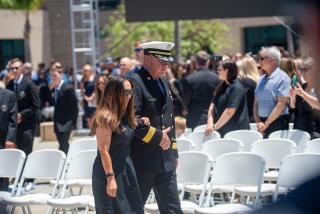Explosion Threat Shuts I-15 in Cajon Pass
- Share via
SAN BERNARDINO — A 20-mile stretch of Interstate 15 through the Cajon Pass was shut down again Monday after a chemical reaction in a tank car that overturned in last week’s fatal train derailment threatened to explode.
“This tank started to rumble and gurgle,” said Bill Peters, a spokesman for the California Department of Forestry. Officials said the car was so hot that water sprayed on it evaporated in a hiss of steam.
They said the pressurized car was filled with butyl acrylate, a noxious, highly flammable gas used in the manufacture of paints and caulk.
“We are in a definite go-slow, go-safe mode,” Peters said. He said fears that the tank car might explode--hurling flaming debris onto the highway, several hundred yards away--had prompted the decision to close the highway Sunday night.
“It’s an indefinite closure,” he said. “We’re aware of the inconvenience, but public safety is the primary concern.”
The 49-car Burlington Northern-Santa Fe freight train hurtled off the tracks on a curving stretch of the treacherous downhill grade through the Cajon Pass before dawn Thursday, killing the conductor and a trainman and seriously injuring the engineer.
The derailed train burst into flames upon impact and the fire continued to burn fiercely for a day and a half, closing I-15 for more than 30 hours and forcing highway and rail traffic to detour as much as 100 miles around the canyon, which is one of the few gateways through the mountains that ring the Los Angeles Basin.
The highway reopened Friday afternoon as the flames died down enough for cleanup crews to start mopping up. The work proceeded smoothly until about 10:30 p.m. Sunday, when someone heard an ominous rumbling from within the overturned tank car.
Peters said hazardous-materials experts from Rohm and Haas Co., which owns the car, warned that there was potential for an imminent explosion that could hurl debris up to three-quarters of a mile. The experts recommended that the area be cleared immediately.
“We didn’t have to be told twice to leave,” Peters said.
Firefighters turned off their hoses, dropped their gear and ran, deputy state Fire Chief Paul Benson said. “Their eyes were as big as saucers,” he said.
The California Highway Patrol quickly reclosed I-15.
Jack Coe, a public affairs officer with Rohm and Haas, said that Thursday’s crash had left the tank car sitting atop a pile of burning wreckage. He said the fire from the wreckage apparently heated the contents of the car, setting off a chemical reaction inside.
Coe said that as the reaction continued, the pressurized gas in the 20,000-gallon tank probably “cooked” until it resembled a soft-boiled egg, rubbery on the outside, soft and liquid at the core.
Temperatures mounted to hotter than boiling water and internal pressures soared, threatening to burst the car open in an explosion of searing chemicals and shattered debris. By Monday afternoon, temperatures within the car began to cool. Coe said the chemical reaction apparently was playing itself out. Officials said the danger of an explosion was diminishing.
A demolition team was brought in to study the possibility of reducing the pressure inside the tank car by blowing a small vent hole in it with a shaped charge.
The officials said that if all went well, I-15 would reopen before dawn today and investigators from the National Transportation Safety Board could continue their efforts to figure out what caused the crash.
There are unconfirmed reports that crew members radioed frantically that the train was accelerating down the grade out of control and that they were preparing to jump.
More to Read
Sign up for Essential California
The most important California stories and recommendations in your inbox every morning.
You may occasionally receive promotional content from the Los Angeles Times.













